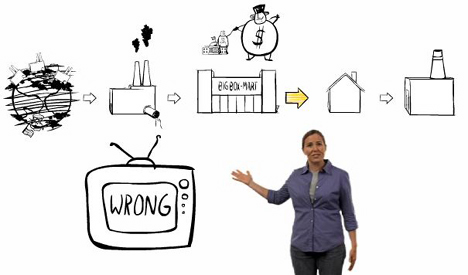Six years ago, Annie Leonard released The Story of Stuff, a compelling 20-minute video in which Leonard illustrated the vicious cycle of unbridled consumerism from factory to daily life to landfill.
“We have a problem with Stuff,” Leonard declared. “We use too much, too much of it is toxic, and we don’t share it very well. But that’s not the way things have to be. Together, we can build a society based on better, not more; sharing, not selfishness; community, not division.”
It was a brief animated statement that became a movement (500,000 worldwide members and counting).
Soon, there were more movies—stories of bottled water, cosmetics, electronics, and so on.
While each video addressed ideas for working toward happy endings, Leonard just released a fabulous finale to her “stuff” series that hits the cumulative nail on the head:
The Story of Solutions.
“In what I call the ‘Game of More,’ politicians cheer a steadily growing economy at the same time as our health indicators are worsening, income inequality is growing, and polar icecaps are melting,” writes Annie Leonard in this month’s issue of YES! Magazine. “But what if we changed the point of the game? What if the goal of our economy wasn’t more, but better—better health, better jobs, and a better chance to survive on the planet? Shouldn’t that be what winning means? That’s the question I ask in my new movie.”
Leonard points us to the plastic packaging problem as a case in point.
“Game of More” solutions include initiatives that reward people with gift cards to buy things if they recycle plastic bags and containers. Sounds like a nice idea, but think about it: This strategy really just encourages a “more is better” economy.
Leonard proposes new solutions such as campaigns that are trying to ban plastic packaging. “By volunteering their time, these citizens are declaring that there’s something more important to them than just earning and spending more,” she explains. “To win this campaign, these citizens are going to have to team up with forward-thinking businesses offering alternatives to throwaway plastic packaging.”
Changing the goal of the entire economy—from more to better—is a monumental undertaking. Annie Leonard doesn’t deny it.
“We can’t do it all at once. But I argue that by focusing on game-changing solutions, we can steadily build an economy that values things like safer, healthier, and more fair as much as we currently value faster, cheaper, and newer,” she says.
Take nine minutes to hear more of Leonard’s spot-on logic (seriously spot-on—I love this woman) in the Story of Solutions video, below:























































Although I can’t listen to the video right now (it’s still a bit too early for the rest of the household:-) I wholeheartedly agree with the concept.
“We use too much, too much of it is toxic…” Yes, I do so agree, case in point. Yesterday I went to the grocery store & bought 2 new (generic store brand) toothbrushes. When I cracked open & peeled back the new plastic toothbrush packaging, out wafted a horrendous odor…I’ll liken this smell to formaldehyde.
The smell was nauseating & I could hardly imagine using this toxic (so called) oral cleaning device. But I gave it the old college try after I thoroughly washed the TB in hot water with soap & then soaked it in peroxide. It’s still impossible to use these TB’s for anything other than cleaning…?…to be honest, the smell is so horriffic, I can’t even imagine using them for cleaning toilets. Why bother making products that are so dangerous to those who make them (can you imagine what that factory must smell like) & certainly not safe for someone to use orally? It’s such a waste of energy, funds & time as well.
I’m appalled to find that almost all toothbrushes are from China, and that would explain your experience. I read labels and try to avoid as much as I can that’s been imported from China – who is getting a bad rap here, but I’m sorry, it’s deserved! Read the labels on your toothpaste – last time I could find only one brand and type that was labeled “made in USA.”
Some one commented on the fact that they could not find toothpaste made in the U.S. My son is a truck driver and was sent to Texas to pick up a load that had come from Mexico. It was a truckload of toothpaste! After that I began looking for a toothpaste that was manufactured in the U. S. I, also, found only one. Read your labels carefully folks. Most everything says “distributed in the U.S.” NOT “made in the U.S.”
You cannot argue one point that is pointed out! Here in the US , the cheap availability of food and goods has just fed us into a stuff gluttony of over consumption. People are now hooked on stuff simply because it is so readily available , including easy credit card abuse. Changing this trend will require much insight and work from each one of us.
Wow, brilliant! Everyone in the USA has and buys too much stuff. After having traveled to over 5 continents, I have seen what most people own and have and it’s so little. Yet most of them are happy. And the ones who are in need, we need to provide for. Like safe drinking water, a way to grow their own food and education for their children.
When I talk to local people about what they do for fun or with their spare time, the answer is almost always : shopping. This is wrong. This is the number one way they are spending time with their kids too. Double wrong.
It’s time to implement some of the solutions in this great little video. And the big one for me: PRACTICE GRATITUDE for all that you have.
Pingback: Holiday Gift Registry? | Raising Jane Journal